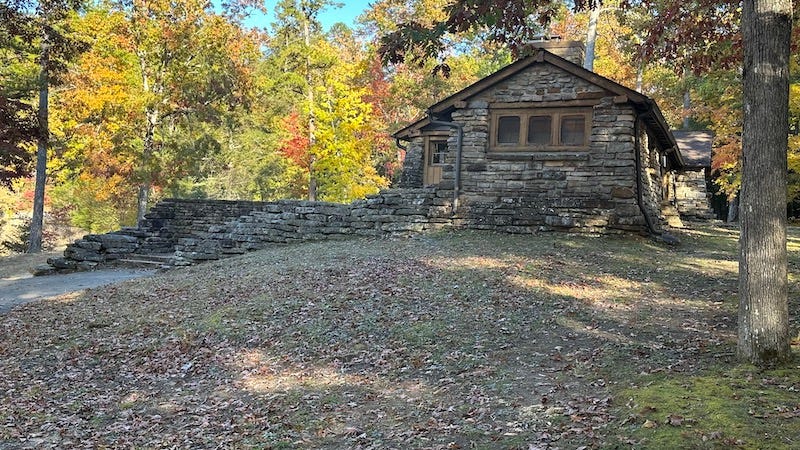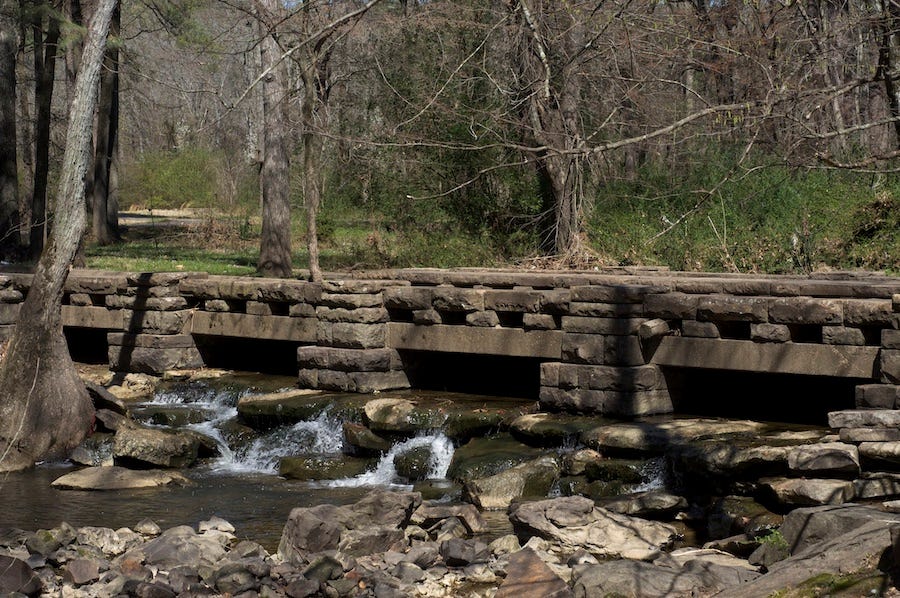Go Read the River
Short takes » Photographs » Pickett CCC Memorial State Park, Tennessee's Uber State Park offers exquisite buildings, trails and CCC wonders
The Civilian Conservation Corps
“Whoever fights the future has a mortal enemy, a faceless enemy, because the future has no being of its own. It steals its being from each man and once it’s tricked him of his secrets it appears outside him. A predator he must meet. But it can be met and it can be vanquished if only he will reach out for it with open arms and a hungry heart.” ≈ Sterling Siliphant

The image above was made at Pickett CCC Memorial State Park. The leaves are beginning to turn all around, which you’ll catch below in the shot of the actual museum on site a this stunningly beautiful park. I was looking for a shot which would illustrate the dynamism of this Tennessee State Park.
All of the original CCC built facilities are on the National Register of Historic Places.
I had about an hour and a half upon arrival to cover as much ground as possible.
A week is in my future at this Park. Maybe two. Soon, I hope.
In 2015, Pickett CCC Memorial State Park and Pogue Creek Canyon State Natural Area earned Silver-tier International Dark Sky Park designation. It became the first state park in the Southeast to gain this prestigious recognition. Visitors can enjoy sweeping, rich views of the night sky similar to those found in many of the Western states. ≈ Tennessee State Parks
It was cold day, and the winds were shearing in down-current gusts at the visitor center. Looking at the time was a bit nerve-wracking until I walked into the building and saw three park officials wrapping up their day. I explained very quickly what I was about to do, and that I had never been here.
”Could y’all put your heads together quickly and spot the map for me? I’m mainly looking for the CCC builds.”
One went to get a map while the other two invited me into their office to hit me with a few questions. By the time the map arrived, the three of them had a rapid-fire brainstorming session in session, and in ten minutes I had around thirty sites in tow on a large map they offered. Now it was just a matter of paying attention to the three or four sections of the Park which were one-way roads.
Daybreak and the gloaming are my favorite times to shoot.
Preferably in slower motion.
Read the River
"Testing, testing."
"Testing...testing..."
Tiny soliloquies barely
piercing the quiet
...from across the water.
Reading the river
while a voice
drifts back to
"Testing, testing."
There is no static here.
"All is quiet on the Western front."
≈ Tom Ogburn

As I was writing this Short Take, where I’m usual adding a few thoughts on my images, I thought I’d also mention a few of the steps I take when preparing for photography shoots in our nation’s park systems.
Get online and do your preparatory scans of an area, especially the parks. Look at the images on local group outdoor and park sites. Keep your eyes peeled for sites, especially any with really well designed graphic maps.
To me, the best way to shoot a Park is to plan for a week’s visit, if a small park. The first two days, speak to the Rangers, let them know what you’re doing and send them your site to hopefully scan, best if before your visit. Often times, after seeing your work, they’ll be more aware of the range of shooting you practice. This often will result in better leads, for they know their parks and facilities.
For me, as I tend to shoot with abstractions in mind often, and within that realm then begin to draw down onto very structural, textural, and go for stark and Spartan images. The Aaron Siskind world view, as I love his works.
When I begin my walking surveys, I pin places on my iPhone and drop notes as to whether I think it may have greater potential at end or start of the day. I ask about the sites or views that offer a strong dynamic range for two to three hours. Which is best for morning or late afternoon; better yet, which are awesome at both times a day.
I keep all these notes in…you got it—Apple Notes. I can share images into them to trigger memory; showing my viewpoint, the location on my person when I noted time of day, light, etc… [Hint: reduce the size before sharing to Notes, it speeds up share] Then as you revisit your favorite sites, you can add comparative notes. Pin like all hell and don’t be shy about using Siri on walking mode to help you get there sooner on you next subsequent shots.
An even better idea—spend two weeks, slow down (I keep saying this to myself) go on walkabouts for random pleasure, and make some wonderful shots just for the fun of it. I do try to pace myself with more stop, look and listen time these days, but on this particular day I truly was in top cruise mode.
Some days are like that.
The Pickett CCC Memorial State Park, northeast of Jamestown, in the Cumberland Mountains of Tennessee was classed as a Dark Sky Park in 2015 by the International Dark-sky Association. I was only at there for an hour and a half the day I dropped in, so I missed seeing the night sky.
This place is out of Time. It’s builds are some of the most distinctive and stunning creations made by hand that I’ve laid eyes upon personally. It’s very high on my list for a much longer return trip. I also need to thank those three Rangers, possibly one the Museum Director and Curator, again for the great job they did in providing me with such a well-marked site map that day!
This will be the first time I’ve posted an image by another photographer. It’s a great lower perspective shot of this bridge. He’s credited in the caption below.
I can see this being done in the future, especially with regards to images of CCC structures around the country and the Blue Ridge Mountains region, including Hurricane Helene’s damages throughout the region.

An earlier post from September 4th this year on another remarkable Tennessee home. The Walker Sisters’ home at the northern end of Little Greenbrier Cove in the Great Smoky Mountains National Park, not far from Gatlinburg, Tennessee.
Haint in the window pane
I’ve been on a ghost kick lately, and the Smokies have a way of making everything seem ghostly. I really wanted this direct-on angle for this shot, and for the life of me I though I had positioned myself out of the frame (on two or three ways even) and, salt to the wound, could have sworn I’d finally cleared my reflection from all the panes. But that bo…
Pickett CCC Memorial State Park:
https://tnstateparks.com/parks/pickett
The Civilian Conservation Corps:
https://en.wikipedia.org/wiki/Civilian_Conservation_Corps
Federal Art Project:
https://en.wikipedia.org/wiki/Federal_Art_Project
The Federal Emergency Relief Administration: https://en.wikipedia.org/wiki/Federal_Emergency_Relief_Administration
All three photos, “Go Read the River,” the Bath House, and the CCC Museum are Copyright 2025 by Tom Ogburn; words all rights reserved.
A detour via the magic of CBS when it was in its heyday, both for National News and Programming. CBS believed in and championed this series for four years.
“Go Read the River,” Episode 24, Season 2 of “Route 66,” and worth a watch. Filmed, as each and every episode was, on location. In this instance at Lake Havasu, Arizona. I visited it for work on my “Route 66” series. Stirling Siliphant’s idea was unique: to travel around America, sponsored by Chevrolet, in a caravan of between 46 to 60 vehicles per season.
He wrote many of the screenplays on the fly, often using locals’ stories shared with him along the road.
The last season was shot almost wholly in Florida, with a few locations in Georgia, possibly one between Daufuskie Island and Bluffton, South Carolina, and Alabama. This due to a reduced budget for what was to become one of the most iconic television series ever filmed.
Siliphant’s original premise was to research each and every site location throughout the United States to complete at least one work on each of the 128 episodes.
While photographing the original site locations intrigued me, I placed the series on hold in 2016. After locating and visiting five out West in 2013-2015, I was allowed first-hand experience on why CBS and Chevrolet cut the budget in the show’s final season.
An RV would drastically improve the odds for rebooting my own series of the “Route 66” works.



